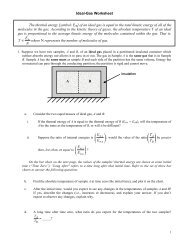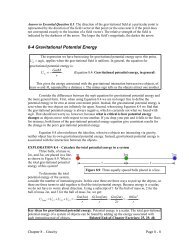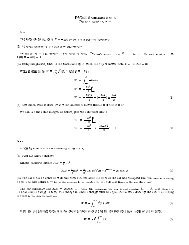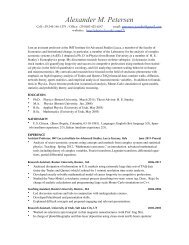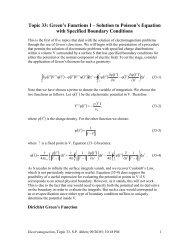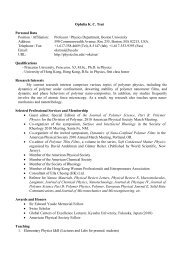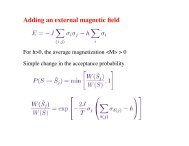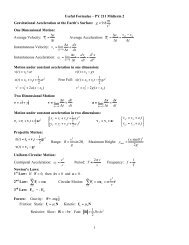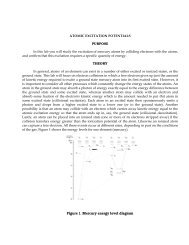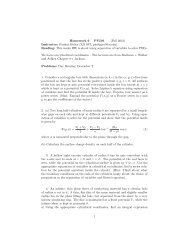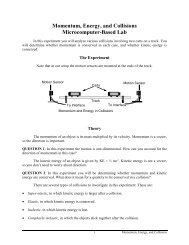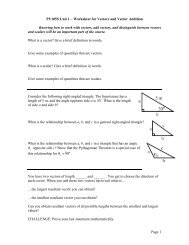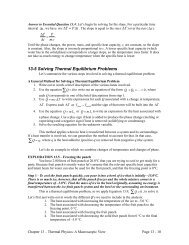Brett Chizinski - Boston University Physics Department.
Brett Chizinski - Boston University Physics Department.
Brett Chizinski - Boston University Physics Department.
You also want an ePaper? Increase the reach of your titles
YUMPU automatically turns print PDFs into web optimized ePapers that Google loves.
Sagittarius A*: Stellar<br />
Observations and Analysis<br />
<strong>Brett</strong> <strong>Chizinski</strong><br />
<strong>Boston</strong> <strong>University</strong> <strong>Department</strong> of<br />
Engineering
Overview<br />
• General View of Galactic Center<br />
– Proposed Models for SgrA*<br />
• Observational Data<br />
– Andrea Ghez<br />
– Data Reduction<br />
– Stellar Orbits: Ghez et al.<br />
– Orbit of S2 with NAOS-CONICA<br />
• Analysis<br />
– Ghez et al.<br />
– S2<br />
• Future<br />
• Conclusion
Views of the Galactic Center:<br />
Radio<br />
X-ray<br />
Infrared
Proposed Models for SgrA*<br />
• 1. Supermassive Black Hole<br />
• At least 10 5 M s<br />
• 2. Fermion Ball Model*<br />
• Condensation of heavy (~17 keV) ,<br />
degenerated fermions<br />
• 3. Cluster of Dark Astrophysical Objects<br />
• Neutron stars or stellar black holes<br />
• 4. Ball of Bosons
How do we prove it’s a<br />
supermassive black hole?<br />
• Mass – for<br />
supermassive at<br />
least 10 5 M S<br />
• Size – Very<br />
Dense<br />
• Event Horizon –<br />
only way to<br />
prove 100%
Observational Data
Professor Andrea Ghez<br />
• Professor of<br />
Astronomy at UCLA<br />
• UCLA Galactic Center<br />
Group: Principal<br />
Investigator<br />
• Tracking stars for 14<br />
years<br />
• 100 stars analyzed
W. M. Keck Observatory<br />
• Two 10m<br />
telescopes<br />
• Largest<br />
Optical +<br />
Infrared<br />
• Hawaii
Data Reduction: Speckle<br />
Inferometry
1. Average all short<br />
exposures into one<br />
long exposure<br />
2. “Shift-and-Add”<br />
using brightest star<br />
as reference<br />
3. Remove Point<br />
Spread Function<br />
27 April 2006 SgrA*: Stellar Observations and<br />
Analysis- <strong>Brett</strong> <strong>Chizinski</strong><br />
1
Data Reduction: Adaptive Optics<br />
27 April 2006 SgrA*: Stellar Observations and<br />
Analysis- <strong>Brett</strong> <strong>Chizinski</strong><br />
2
27 April 2006 SgrA*: Stellar Observations and<br />
Analysis- <strong>Brett</strong> <strong>Chizinski</strong><br />
3
(Schodel et al.)<br />
27 April 2006 SgrA*: Stellar Observations and<br />
Analysis- <strong>Brett</strong> <strong>Chizinski</strong><br />
4
Stellar Orbits: Ghez et al.<br />
27 April 2006 SgrA*: Stellar Observations and<br />
Analysis- <strong>Brett</strong> <strong>Chizinski</strong><br />
5
Analysis: Ghez et al.<br />
• Velocities measured by red-shift<br />
• 7 orbits deemed accurate for simultaneous<br />
fitting<br />
• Fitted orbits infer center point mass of<br />
(3.7 ± 0.2) x 10 6 M S<br />
• Radius < 10 light days<br />
27 April 2006 SgrA*: Stellar Observations and<br />
Analysis- <strong>Brett</strong> <strong>Chizinski</strong><br />
6
(Schodel et al.)<br />
Observational Data: S2’s Orbit<br />
Reaches Periapse<br />
27 April 2006 SgrA*: Stellar Observations and<br />
Analysis- <strong>Brett</strong> <strong>Chizinski</strong><br />
When:<br />
Spring 2002<br />
Where:<br />
17 light hours from<br />
SgrA*<br />
Speed:<br />
over 5000 km s -1<br />
Measured By:<br />
NACO<br />
7
27 April 2006 SgrA*: Stellar Observations and<br />
Analysis- <strong>Brett</strong> <strong>Chizinski</strong><br />
8
Analysis: S2 Orbit<br />
• 3.7 ± 1.5 x 10 6 M S<br />
• Radius < 17 light hours<br />
• Fermion Ball Model: fermion mass > 74 keV<br />
(100000 times greater than most massive<br />
neutrino recorded)<br />
• Cluster cosmic objects: lifespan of ~10 5<br />
years, Milky Way ~10 9 years old, extremely<br />
unlikely<br />
• Ball of Bosons: Would collapse into black<br />
hole eventually<br />
27 April 2006 SgrA*: Stellar Observations and<br />
Analysis- <strong>Brett</strong> <strong>Chizinski</strong><br />
9
So…is it a black hole?<br />
• Mass-------<br />
• Size--------<br />
• Event------<br />
Horizon<br />
27 April 2006 SgrA*: Stellar Observations and<br />
Analysis- <strong>Brett</strong> <strong>Chizinski</strong><br />
10
Future: Further Investigations<br />
• Data Refinement<br />
– Distance estimate = 19% mass uncertainty<br />
• Event Horizon<br />
– Observe mass being “eaten”<br />
• Star Formation<br />
– Young stars in unhospitable region<br />
27 April 2006 SgrA*: Stellar Observations and<br />
Analysis- <strong>Brett</strong> <strong>Chizinski</strong><br />
11
Conclusion<br />
• 3.7 x 10 6 M S object<br />
• Radius no more than 10 light days<br />
• Density of at least 6.5x10 21 M S /pc 3<br />
• Supermassive black hole model most<br />
fitting<br />
• Evidence of event horizon needed<br />
27 April 2006 SgrA*: Stellar Observations and<br />
Analysis- <strong>Brett</strong> <strong>Chizinski</strong><br />
12
27 April 2006 SgrA*: Stellar Observations and<br />
Analysis- <strong>Brett</strong> <strong>Chizinski</strong><br />
13
Works Cited<br />
• Schodel, R et al. “A star in a 15.2-year orbit around the<br />
supermassive black hole at the centre of the Milky Way.”<br />
Letters to Nature. 10/17/02; 694-696.<br />
• Shen, Zhi-Qiang. “A size of ~1 AU for the radio source Sgr A* at the<br />
centre of the Milky Way.” Letters to Nature. 11/03/05; 62-64.<br />
• Ghez, A. M. et al. “Stellar Orbits Around the Galactic Center Black<br />
Hole.” Astrophysical Journal. 02/20/05; 744-757.<br />
• Hawking, Stephen. The Universe In a Nutshell. New York: Bantam<br />
Books, 2001. Pages 110-122<br />
• Schodel, R et al. “Stellar Dynamics in the Central Arcsecond of our<br />
Galaxy.” Astrophysical Journal. 10/20/03; 1015-1034<br />
27 April 2006 SgrA*: Stellar Observations and<br />
Analysis- <strong>Brett</strong> <strong>Chizinski</strong><br />
14


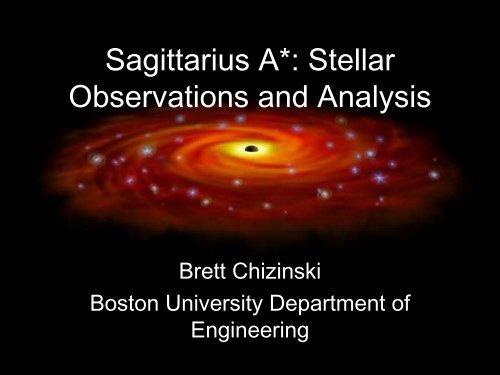
![arXiv:1303.7274v2 [physics.soc-ph] 27 Aug 2013 - Boston University ...](https://img.yumpu.com/51679664/1/190x245/arxiv13037274v2-physicssoc-ph-27-aug-2013-boston-university-.jpg?quality=85)
